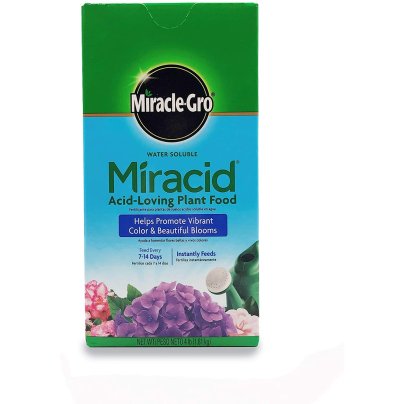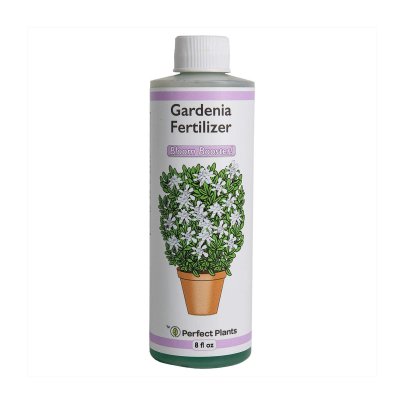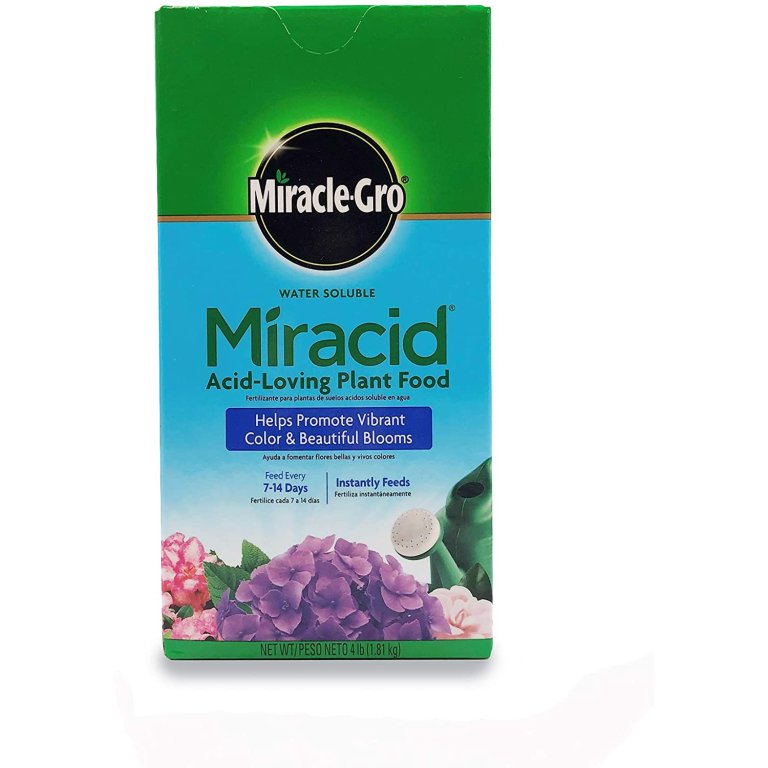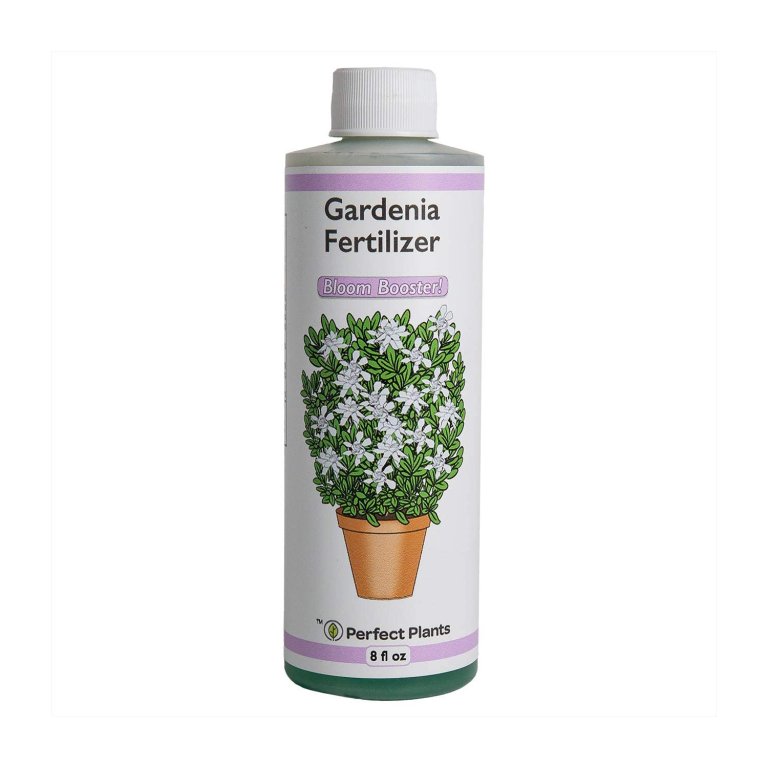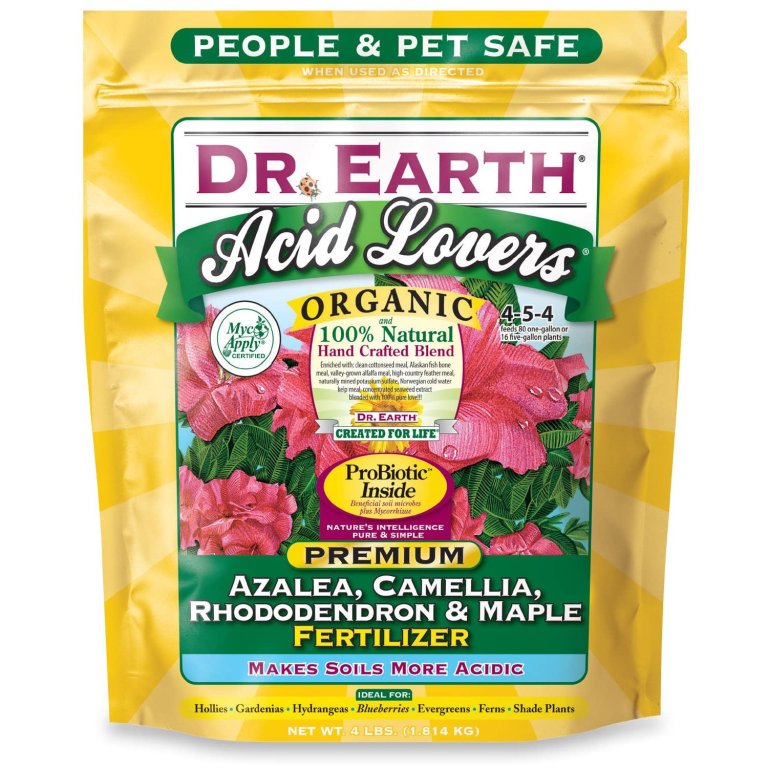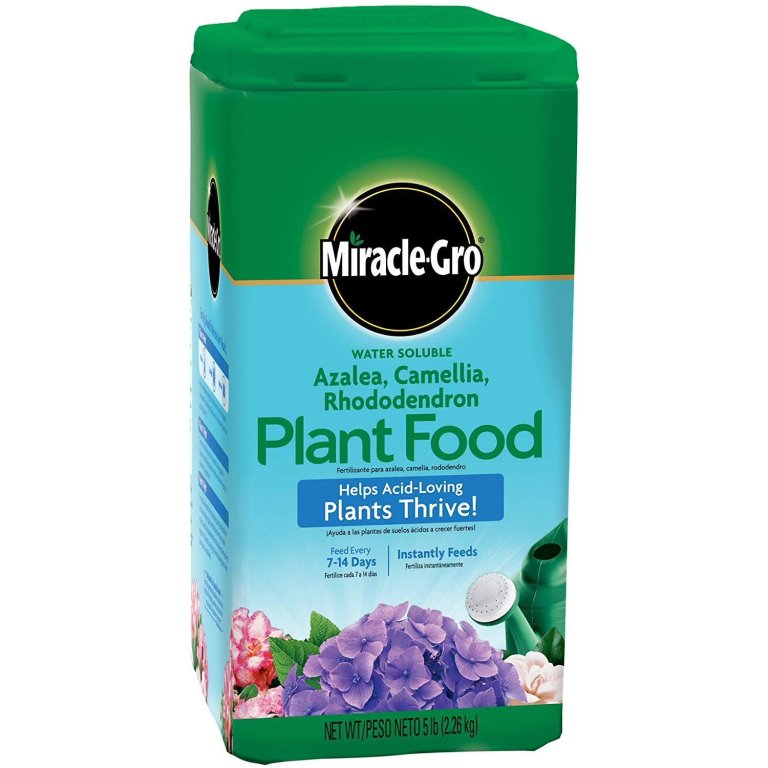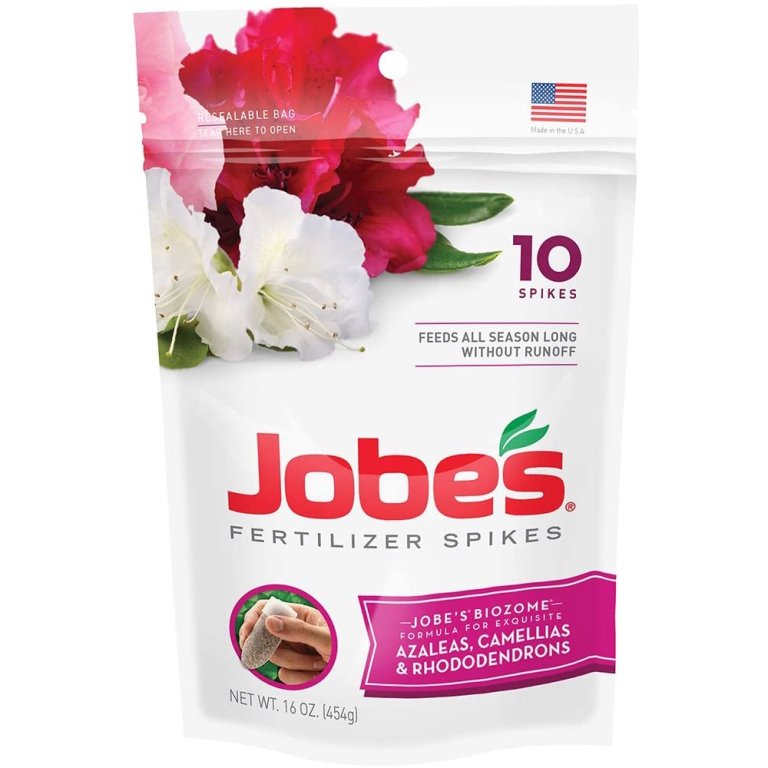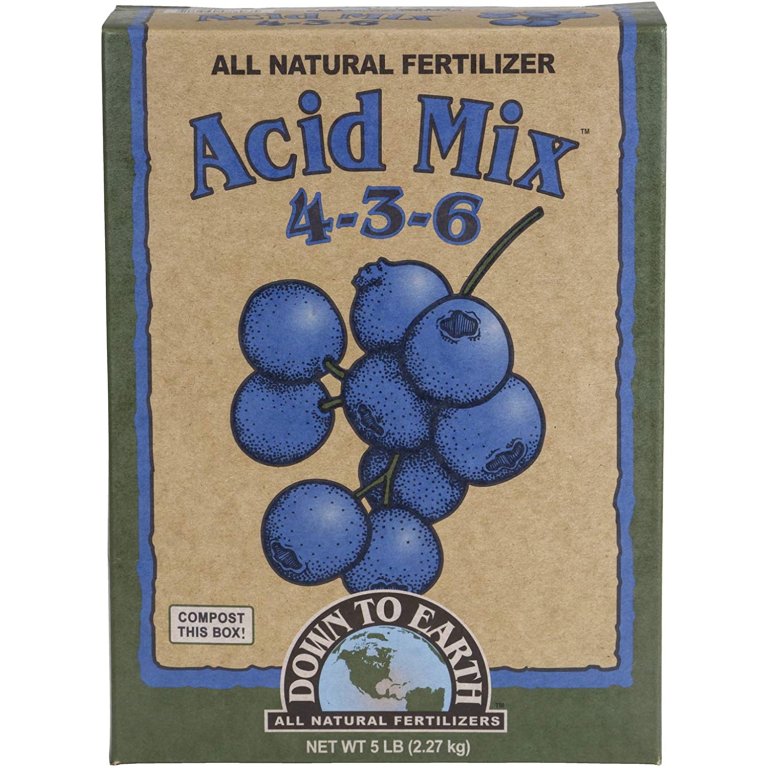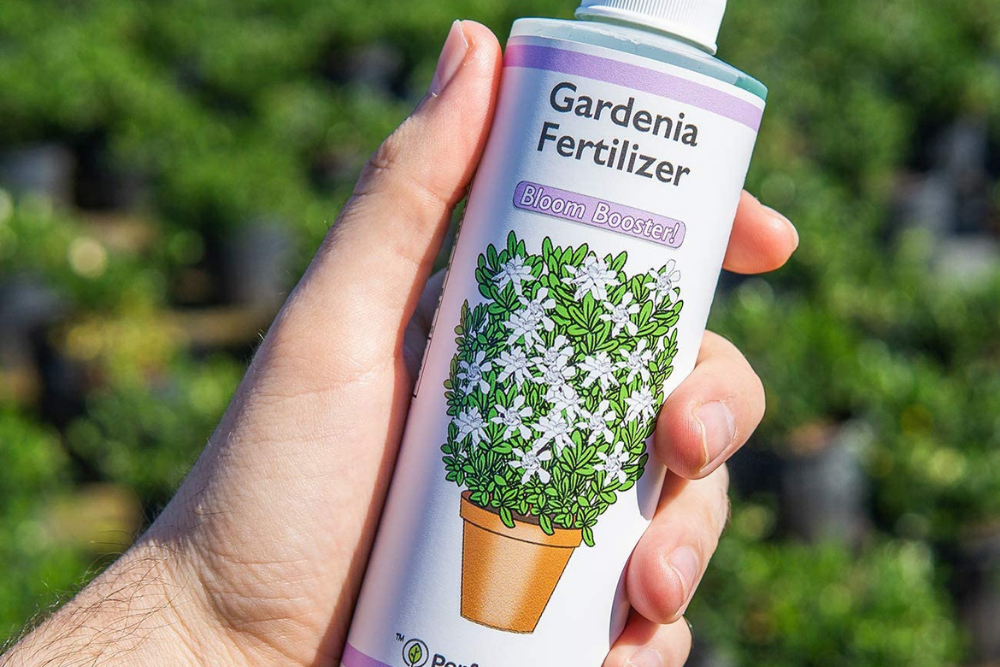
We may earn revenue from the products available on this page and participate in affiliate programs. Learn More ›
Those who live in temperate climates—typically where winter temps don’t drop below 10 degrees Fahrenheit—may be interested in growing gardenias in their garden. These are shrubs known for their soft, large, typically white blossoms that give off a heady aroma. While the gardenia (Gardenia jasminoides) isn’t difficult to grow, it has a few soil requirements. In addition to choosing the right type of soil for gardenias—well-draining and amended with organic matter, such as mulch or dry leaves—the plant stands a better chance of developing healthy roots and producing blooms if it receives regular fertilizer feedings.
But don’t just grab the first package of all-purpose plant food you see off the shelf at the garden center. It might boost the gardenia bush’s foliar growth, but it might not encourage blooming. The best plant food for gardenias should be formulated to provide the nutrients acid-loving plants need for optimal results. Our favorite is Scotts Miracle-Gro Miracid Plant Food because it dissolves quickly and has added minerals. Ahead, learn what to look for when shopping for the best fertilizer for gardenias and find out why the following products fit the bill.
- BEST OVERALL: Scotts Miracle-Gro Miracid Plant Food
- BEST BANG FOR THE BUCK: Perfect Plants Gardenia Liquid Fertilizer
- BEST ACIDIFIER: Jobe’s Organics Soil Acidifier Fertilizer
- BEST WITH MICROBES: Dr. Earth Organic Acid Lovers Fertilizer
- BEST WATER-SOLUBLE: Miracle-Gro Water Soluble Azalea, Camellia Plant Food
- BEST SPIKES: Jobe’s Azalea, Camellia & Rhododendron Fertilizer
- ALSO CONSIDER: Down to Earth All Natural Acid Mix Fertilizer

Product Comparison
| NPK Analysis | Fertilizer Type | Added Ingredients | |
| Scotts Miracle-Gro Miracid Plant Food | 30-10-10 | Water-soluble | Trace minerals |
| Perfect Plants Gardenia Liquid Fertilizer | 9-3-6 | Liquid | Sulfur, magnesium, copper, iron, manganese, and molybdenum |
| Jobe’s Organics Soil Acidifier Fertilizer | Not applicable | Granules | None (sulfur only) |
| Dr. Earth Organic Acid Lovers Fertilizer | 3-4-3 | Granule | Land plants, ocean plants, fish, fish bones, and mined minerals |
| Miracle-Gro Water Soluble Azalea, Camellia Plant Food | 30-30-10 | Water soluble | Iron, boron, copper, manganese, molybdenum, zinc, and boric acid |
| Jobe’s Azalea, Camellia & Rhododendron Fertilizer | 9-8-7 | Spikes | None listed |
| Down to Earth All Natural Acid Mix Fertilizer | 4-3-6 | Time-release granules | Trace minerals, calcium, magnesium, and sulfur |
Our Top Picks
To earn a spot in this lineup, the following fertilizers had to contain ingredient formulations that offered the vital nutrients that gardenias need for healthy growth and abundant blossom development. The NPK analysis varies from product to product, and some contain no NPK components at all. Still, each is designed to benefit gardenias and other acid-loving plants.
Best Overall
Scotts Miracle-Gro Miracid Plant Food
Pros
- Dissolves quickly in water
- Nitrogen sources help acidify soil
- Added minerals
Cons
- Requires frequent feedings
Product Specs
- NPK analysis: 30-10-10
- Fertilizer type: Water-soluble
- Added ingredients: Trace minerals
From one of the top names in gardening aids, the best overall pick for feeding gardenias is Scotts Miracle-Gro Miracid Acid-Loving Plant Food. This water-soluble fertilizer is designed to be mixed with water and poured over foliage or around the base of the plant. It can also be used in a garden hose dispenser and sprayed over plants on a broader scale. The granules dissolve rapidly and provide a quick boost for the plant.
Miracid features an NPK analysis of 30-10-10, with its nitrogen sourced from ammonium and urea, both of which help acidify the soil. Trace minerals are also included, with boron, copper, iron, and zinc rounding out the nutrient quotient. Miracle-Gro recommends feeding when the gardenia is first transplanted and every 7 to 14 days after that during its growing season.
Get the Scotts Miracle-Gro Miracid on Amazon or at Ace Hardware.
Best Bang For The Buck
Perfect Plants Gardenia Liquid Fertilizer
Pros
- Up to 48 feedings
- Affordable
- Added nutrients
Cons
- Requires frequent feedings
Product Specs
- NPK analysis: 9-3-6
- Fertilizer type: Liquid
- Added ingredients: Sulfur, magnesium, copper, iron, manganese, and molybdenum
Those who want to keep gardenias healthy and happy on a budget should check out Perfect Plants Gardenia Fertilizer, since a single 8-ounce bottle will last for the entire growing season. Just a teaspoon of this concentrated liquid mixed into a gallon of water can feed one or more gardenia plants weekly or every other week.
This fertilizer has an NPK analysis of 9-3-6, making it well suited for healthy foliage and abundant blossoms on acid-loving gardenias. Other beneficial ingredients include sulfur, magnesium, copper, iron, manganese, and molybdenum—all nutrients ideal for gardenias and other acid-loving plants.
Get the Perfect Plants Gardenia Fertilizer on Amazon.
Best Acidifier
Jobe’s Organics Soil Acidifier Fertilizer
Pros
- Reduces pH in soil
- Requires only two to three yearly doses
- Easy-to-use granules
Cons
- Contains no other nutrients
Product Specs
- NPK analysis: Not applicable
- Fertilizer type: Granules
- Added ingredients: None (sulfur only)
Rather than struggle with overly alkaline soil, consider feeding with Jobe’s Organics Soil Acidifier, which can help create the ideal pH for gardenias to thrive. This granular product contains no nitrogen, phosphorus, or potassium. Instead, the formula features 100 percent sulfur—an excellent soil acidifier—sourced from elemental sulfur and gypsum.
For best results, test the soil before applying Jobe’s acidifier and then follow the directions for sprinkling the granules around the plant base (how much to use depends on plant size). Work the granules into the soil and water well. Reapply the acidifier two or three times per year to maintain an optimal pH balance. Tip: This product does not contain other nutrients, so consider feeding with other fertilizers described in this guide to boost healthy gardenia growth.
Get the Jobe’s Organics Soil Acidifier on Amazon.
Best With Microbes
Dr. Earth Organic Acid Lovers Fertilizer
Pros
- Reduces soil alkalinity
- Time-release granules
- All natural
Cons
- Slight objectionable smell
Product Specs
- NPK analysis: 3-4-3
- Fertilizer type: Granule
- Added ingredients: All-natural ingredients sourced from land plants, ocean plants, fish, fish bones, and mined minerals
Dr. Earth’s Acid Lovers Organic Fertilizer goes a long way toward helping maintain the acidic soil gardenias prefer. It also helps improve soil quality by adding probiotic microbes: tiny microorganisms that add organic content and boost soil’s structure. The ingredients in Dr. Earth are 100 percent natural and designed to encourage abundant blooming.
Among the included microbes are eight strains of ecto and endo mycorrhizae (mushroom-based components) that help plant roots withstand the slight drought conditions that can occur if a watering is inadvertently missed. The granules should be spread around the base, worked into the top inch or so of soil, and then watered thoroughly. For the best results, reapply Dr. Earth every 6 weeks.
Get the Dr. Earth’s Acid Lovers Organic Fertilizer on Amazon or at Ace Hardware.
Best Water-Soluble
Miracle-Gro Water Soluble Azalea, Camellia Plant Food
Pros
- Dissolves rapidly
- Offers instant boost of nutrients
- Acidifies soil
Cons
- Requires frequent application
Product Specs
- NPK analysis: 30-30-10
- Fertilizer type: Water soluble
- Added ingredients: Iron, boron, copper, manganese, molybdenum, zinc, and boric acid
This water-soluble Miracle-Gro fertilizer dissolves instantly in water to provide an immediate boost of nutrients for gardenias and other acid-loving plants, including azalea, camellia, and hydrangea. It features an NPK analysis of 30-30-10 for lush leaf growth, abundant bloom production, and healthy root development.
In addition, Miracle-Gro added trace minerals to assist in acidifying the soil for even better growth. The product can be mixed with water in a watering can and applied to foliage or poured directly around the plant’s base; it can be used in a garden hose dispenser for spraying large areas. Recommended application is every 7 to 14 days.
Get the Miracle-Gro Azalea and Camellia Plant Food on Amazon or The Home Depot.
Best Spikes
Jobe’s Azalea, Camellia & Rhododendron Fertilizer
Pros
- Time-release feeding
- Feeds up to 8 weeks
- Simple to use
Cons
- Animals may dig them up
Product Specs
- NPK analysis: 9-8-7
- Fertilizer type: Spikes
- Added ingredients: None listed
Those looking for a fertilizer that suits gardenias and other acid-loving shrubs but doesn’t require frequent feeding may find Jobe’s Fertilizer Spikes to be just the ticket. This product contains an NPK analysis of 9-8-7 combined in tightly compressed spikes that dissolve gradually to provide a long-term, continuous supply of nutrients.
Push the spikes about an inch beneath the surface of the soil around the base of the plant (the number of spikes depends on plant size, so follow package directions) and water thoroughly. Jobe’s spikes will continue to feed gardenias, azaleas, and similar flowering shrubs for 8 weeks.
Get the Jobe’s Fertilizer Spikes on Amazon or True Value.
Also Consider
Down to Earth All Natural Acid Mix Fertilizer
Pros
- Acidifies soil
- Requires only three feedings per year
- Improves soil content
Cons
- Pricey
Product Specs
- NPK analysis: 4-3-6
- Fertilizer type: Time-release granules
- Added ingredients: Trace minerals, calcium, magnesium, and sulfur
Down to Earth All Natural Acid Fertilizer is designed to feed acid-loving plants the nutrients they need while improving soil content in the process. The fertilizer has an NPK analysis of 4-3-6 and also provides trace minerals, calcium, magnesium, and sulfur to help acidify the soil and encourage nutrient uptake in the roots. Down to Earth has also amended its product with leonardite, a natural, mineral-based soil conditioner.
The manufacturer recommends applying these time-release granules in early spring, again in summer when blooms first appear, and once more in fall to promote root development and increase the plant’s resistance to winter temperatures.
Get the Down to Earth All Natural Acid Fertilizer on Amazon or at Walmart.
Our Verdict
While any of the fertilizers in this lineup are beneficial for feeding gardenias, Scotts Miracle-Gro Miracid Plant Food is an excellent choice for helping maintain the acidic soil gardenias prefer. For a budget-friendly fertilizer that goes a long way, we like Perfect Plants Gardenia Fertilizer; it comes in a concentrated liquid that makes up to 48 gallons.
What to Consider When Choosing the Best Fertilizer for Gardenias
The best food for gardenias is easily absorbed by the plant’s roots. It boosts both overall plant growth and blossom production, and it should encourage robust root development. Beneficial products are available in several types and formulations.
Types of Fertilizer
Today’s fertilizers come in various types, and some are better suited to specific growing conditions than others.
- Granular: Designed for gradual release, granular fertilizers resemble tiny pellets or grains of sand. They’re designed to be mixed into the top inch or so of the soil, where they gradually dissolve, providing the plants with a continuous supply of food for several weeks, depending on brand.
- Liquid: Liquid fertilizer comes in two forms: ready-to-use sprays for application directly on foliage or in concentrated form that’s mixed with water and sprinkled on the leaves or poured near the plant’s base. Plants absorb liquid fertilizers quickly—so they’re good for a quick boost—but they also drain out of the soil quickly, so they should be applied frequently, some even weekly.
- Spikes: Like granules, spikes provide time-released feedings. They’re inserted below the soil level near the plant base to feed the plant for up to 6 months.
- Water-soluble: This type of fertilizer comes in a grainy or powdery form that dissolves rapidly in water. It can be applied via a garden hose dispenser or mixed with water in a watering can and then poured over the plant or soil.
Soil Acidity and NPK Ratio
Understanding soil and fertilizer nutrient values helps gardeners achieve success. The pH scale measures soil acidity, running from 0 to 14, with 7 considered neutral. Numbers below 7 are progressively more acidic, and those higher than 7 are more alkaline. Gardenias grow best in soil with a pH content on the acidic side, ranging from about 5 to 6.5 on the pH scale.
Fertilizers today are identified by the amount of nitrogen (N), phosphorus (P), and potassium (K) they contain by content. For example, a fertilizer with an NPK analysis of 3-3-3 contains equal amounts of each nutrient. These three primary nutrients are designed to boost different parts of plant growth.
- Nitrogen: Responsible for boosting leaf development.
- Phosphorus: Encourages root development and flower production.
- Potassium: Helps ensure root uptake of nutrients and overall plant function.
Fertilizers made for gardenias may have an NPK analysis that’s higher in nitrogen, but nutrient levels vary from product to product, depending on other ingredients in the mix. Some of the best fertilizers for gardenias don’t contain any nitrogen, phosphorus, or potassium at all. Some include components such as sulfur or iron sulfate instead, which increases acidity in the soil and encourages the plant to absorb nutrients better.
The NPK ratio doesn’t tell the whole story when it comes to feeding gardenias; the nutrient source plays a role here as well. For example, the nitrogen found in fertilizer can come from dozens of sources, but if it’s sourced from nitrate (a salt of nitric acid) it will be of less benefit to acid-loving plants than if it’s sourced from ammonium (ammonia combined with a hydrogen ion).
Fortunately, you don’t need a degree in chemistry to choose the best fertilizer for gardenia plants. Instead, look for a fertilizer labeled for “acid-loving plants” or an “acidic fertilizer,” which will gear it toward other acid-loving plants, such as rhododendrons, azaleas, or blueberries. A fertilizer formulated for any acid-loving plant will be beneficial for gardenias.
However, gardenia enthusiasts shouldn’t expect acid-loving fertilizer alone to correct soil that’s too alkaline—it simply cannot do the trick. Instead, test soil before planting via an inexpensive pH test kit (available online and from garden centers). The tests come with suggestions for correcting pH balance, such as adding decomposed compost to the soil to increase acidity. When the soil is in the correct pH range, it’s time to plant gardenias.
Soil Type
Soil is one thing gardenias are especially picky about. These bushy plants like moisture, but they don’t like wet feet, meaning their roots can’t tolerate standing water. Planting gardenias in a raised flower bed can solve drainage problems, but the soil must also be light and resist compaction.
Clay-based soils are thick and heavy and do not permit gardenia roots to develop freely. Soils that are high in decomposed organic matter, such as compost and dried leaves, are lighter in weight, and the decomposed matter also helps raise the acidity level.
While there is not one specific best soil brand for gardenias, those looking to grow gardenias in containers should opt for a commercial potting soil containing peat moss, sand, and perlite—ingredients that encourage drainage while retaining adequate nutrients and moisture.
How We Chose the Best Fertilizer for Gardenias
To arrive at this lineup of the best fertilizers for gardenias, we extensively researched dozens of popular products. We eliminated any fertilizers not explicitly designed for acid-loving plants. Brand reputation was considered—for example, Miracle-Gro, a nationally known manufacturer with an excellent reputation for producing top-quality gardening products and aids. But startup and niche manufacturers weren’t eliminated if their products met the qualifications for being suitable for acid-loving plants. Finally, we looked at the product’s track record as cited by other gardeners who used it.
FAQs
Just a few open gardenia blossoms are sufficient for filling the air with a heady aroma, so it’s no surprise that gardeners and landscapers in moderate climates love growing this bushy plant. Still, gardenias require acidic growing conditions, and using the right fertilizer will help maintain that pH balance. Newbies to growing gardenias are likely to have some questions, the most common of which are answered below.
Q. When should I fertilize gardenias?
While manufacturer recommendations may vary, in general, feed gardenias from March to October but don’t feed during the plant’s resting season from November to February.
Q. How often should I fertilize gardenias?
This depends on the type of fertilizer, so follow manufacturer instructions. You may need to feed every week or so with liquid fertilizer or every few months with spikes.
Q. How do I fix yellow leaves on my gardenia plant?
Yellow leaves may be a sign of poorly draining soil. Consider amending the soil to increase drainage by adding sand, peat moss, or perlite.
Q. How often should I put coffee grounds on my gardenia?
Like Epsom salt, coffee grounds are acidic and can be used occasionally to supplement a good acid-loving fertilizer. Don’t overuse them, however—once a month is probably fine.
Q. Can I use Miracle Grow on gardenias?
Since so many people are familiar with the manufacturer yet err on the name, we kept the common misspelling in this question so folks can find the answer! And the answer is: Yes, our Best Overall pick for a gardenia fertilizer is Miracle-Gro Miracid Acid-Loving Plant Food.
